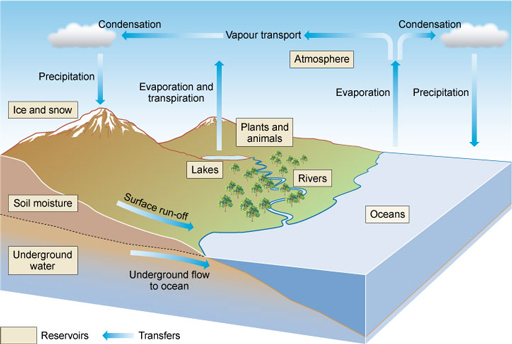4.1 The hydrological or water cycle
Water is continually moving around the Earth and continuously changing its physical form.
In which three forms can water be found on Earth?
Water can be found in liquid form in oceans, rivers, lakes and rain; in solid form in ice and snow; and as a gas (water vapour) in the atmosphere.
The hydrological cycle, or water cycle, is the continuous circulation of water between oceans, atmosphere and land (Figure 4.1). The sun and wind cause water to evaporate (change its physical state from liquid to gas) from land and water bodies (oceans, lakes and rivers). Also, plants take up liquid water and give off water vapour through pores in their leaves in a process called transpiration. The water vapour moves high above the Earth’s surface on rising currents of air through the atmosphere. Eventually as the water vapour reaches the cooler air higher up in the atmosphere, it condenses (changing from gas to liquid) to form clouds and falls back to Earth in the form of rain and snow (together these are called precipitation). Precipitation that falls on land can flow over the surface as run-off into rivers and streams, and can also percolate (trickle down) through the soil into underground rocks to become groundwater.
Water is held in reservoirs (indicated in Figure 4.1) and moves between them in transfer processes. (‘Reservoirs’ here refers to all stores or reserves of water, not just water held behind a dam.) The water transfer processes continue in an ongoing cycle through evaporation and transpiration, transportation of water vapour in the atmosphere, precipitation, and water flowing off and through the land back to the sea.

Why is water described as a renewable resource?
Because the processes of the water cycle are constantly renewing the surface water and groundwater. Precipitation (rainfall) feeds the rivers and streams and infiltrates into the ground to replace the water that we use.
Learning Outcomes for Study Session 4
